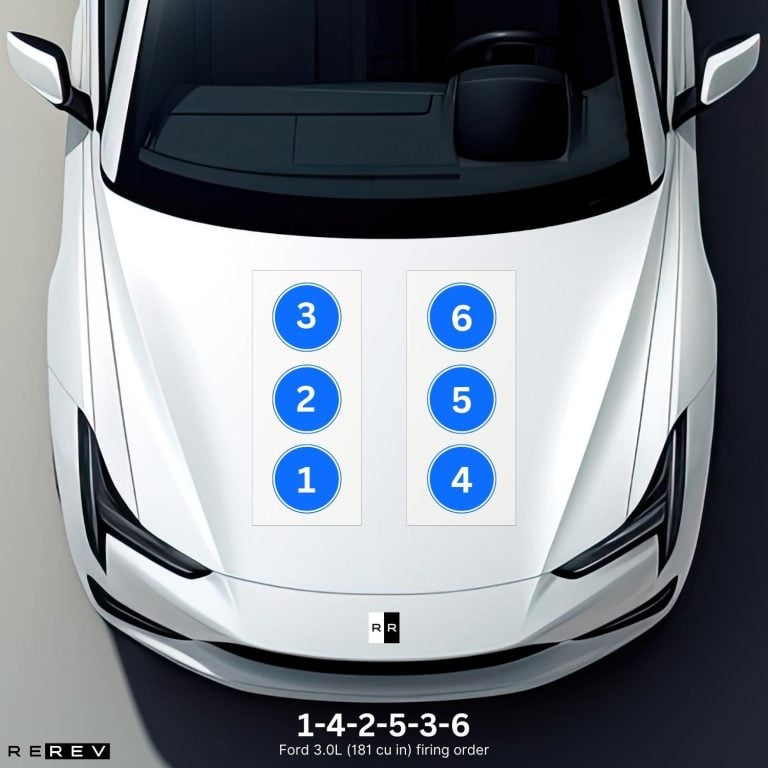Ford 3.0L (181 cu in) firing order — diagram & guide
Essential engine sequence specifics for the Ford 3.0L firing order.

As one of Ford’s engines with a displacement that stuck for a while in different versions, the 3.0-liter V6 has been around for quite some time. The thing is – most drivers seem to have trouble finding the right Ford 3.0L (181 cu in) firing order due to all the different variations of the engine.
So, we’ve decided to come to your rescue and discuss some of the most common 3.0-liter engines that Ford used over the years as well as their firing orders and cylinder positions.
Ford 3.0L Duratec firing order
Out of all the 3.0-liter engines that Ford has made, the 3.0-liter Duratec is perhaps the most recognized one. The Ford 3.0L Duratec firing order is 1-4-2-5-3-6 and this engine was in production for Ford models made from 1996 to 2012.
Over the years, the engine was revised quite a few times and eventually got a VVT (Variable Valve Timing) system. This means that the valve opening was controlled electronically to optimize the fuel efficiency and power output based on the situation.
Still, even with that system, the firing order has remained the same for the lifetime of the engine’s production.
Ford 3.0L Power Stroke firing order
Along with the petrol Duratec V6, Ford also made a six-cylinder diesel engine with the same displacement codenamed “Power Stroke”. It was basically a V6 version of the prominent 6.7-liter and 7.3-liter V8 Power Stroke engines.
The Ford 3.0L Power Stroke firing order is 1-4-2-5-3-6, which was confusing to some drivers since it’s the same firing order as with the petrol Duratec counterpart. However, that’s not so odd when you consider that this engine shares a similar block design as the petrol one.
Ford 3.0L EcoBoost firing order
Finally, we have the latest 3.0-liter EcoBoost engine which is basically an upgrade to the Duratec in the form of a twin-turbo 3.0-liter V6. The Ford 3.0L EcoBoost firing order is 1-4-2-5-3-6, which is once again the same firing sequence.
However, the EcoBoost had two turbochargers and it features the same engine design as the previous Duratec, only with slightly different bores and piston design.
The thing here is that the diesel engine also features the same firing order as the Duratec and the EcoBoost which is almost like a turbo version of the said engine.
Still, there’s one major difference here – the diesel engine doesn’t use spark plugs, so you won’t be able to use the firing order to replace these on a diesel engine.
Ford 3.0L cylinder diagram

While the firing order of the Duratec, the Power Stroke diesel, and the turbo EcoBoost V6 are virtually the same, there are certain differences in the way that these engines are built.
Most notably, we have to address the differences in the cylinder diagram which contains the cylinders 1, 2, and 3 in that order from the passenger’s side, and cylinders 4, 5, and 6 on the driver’s side.
That’s the case with both the Duratec and the turbo EcoBoost engine, while the diesel engine has a reverse numbering of the second bank cylinders 4, 5, and 6.
Ford 3.0L vehicle applications
Finally, we wanted you to have an overview of where all these engines fit in Ford’s lineup over the years, so we made a complete list for all three engines:
Ford 3.0 Duratec:
- Ford Mondeo
- Ford Taurus
- Ford Escape
- Ford Mondeo ST
- Ford Five Hundred
Ford 3.0 Power Stroke diesel
Ford 3.0 EcoBoost:
- Ford Explorer
- Ford Explorer ST
The 3.0-liter EcoBoost was also used in the Lincoln MKZ and the Aviator plug-in hybrid in combination with an electric powertrain component.
Our take
In the end, it all comes down to which type of Ford’s 3.0-liter engine your vehicle uses. While the differences in the firing order are irrelevant, there are quite a few differences in how you can maintain the engine depending on its version.
So, the diesel variant uses glow plugs instead of spark plugs, and the EcoBoost requires turbine rebuilds from time to time to keep the boost optimized. With all this said, we hope that our team was able to help with this guide.